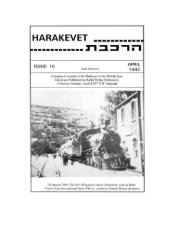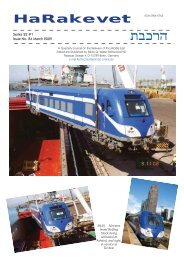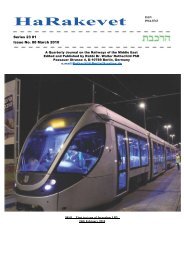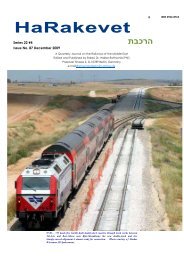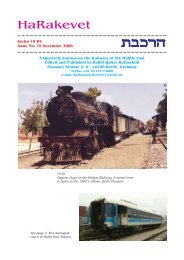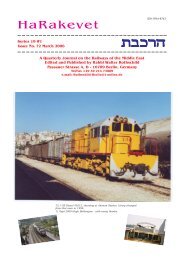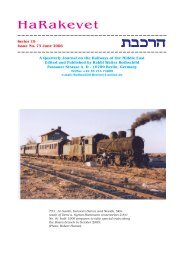Welcome to Issue 7. This has been a long time in ... - HaRakevet
Welcome to Issue 7. This has been a long time in ... - HaRakevet
Welcome to Issue 7. This has been a long time in ... - HaRakevet
You also want an ePaper? Increase the reach of your titles
YUMPU automatically turns print PDFs into web optimized ePapers that Google loves.
14. A TRIP ON THE HEDJAZ RAILWAY IN 1942. By Theo Pelz.<br />
In 1942 1 was serv<strong>in</strong>g with No. 4 Company of the Palest<strong>in</strong>e regiment. We<br />
were stationed <strong>in</strong> Atlit (oposite the immigrants camp;, and our duties<br />
<strong>in</strong>cluded escort<strong>in</strong>g W.D. supplies etc. <strong>in</strong> the Middle East.<br />
We left Atlit on 31st. August 1942 at 1/20 hours by truck, and<br />
arrived at Nesher (the present Army Camp North of the highway) at 1020<br />
hours. We were detailed <strong>to</strong> two (?) open bogie cars loaded with aviation<br />
gasol<strong>in</strong>e for Mafraq <strong>in</strong> Transjordan, and left Nesher next morn<strong>in</strong>g for Haifa<br />
East beh<strong>in</strong>d one of the Krauss 0-6-0 tank locos. The day was spent <strong>in</strong> Haifa<br />
East, and the freight tra<strong>in</strong> tak<strong>in</strong>g us <strong>to</strong> Samakh left only at 2200 hrs. I<br />
do not recall what type of loco was <strong>in</strong> front. I had <strong>in</strong>tended <strong>to</strong> keep awake<br />
and watch the countryside, but I frequently dozed off and do not remember<br />
much of the night trip. Some<strong>time</strong> past midnight we s<strong>to</strong>pped at a station. A<br />
ghaffir (auxiliary policeman; was stand<strong>in</strong>g <strong>in</strong> front of the station<br />
build<strong>in</strong>g, and I asked him where we were. The reply was: "<strong>This</strong> is Shatta<br />
station". The build<strong>in</strong>g is now used as a prison.<br />
We then descended <strong>in</strong><strong>to</strong> the Jordan valley, s<strong>to</strong>pp<strong>in</strong>g at Jisr el<br />
Majamiya, pass<strong>in</strong>g Naharayim Halt after cross<strong>in</strong>g the Jordan bridge, crossed<br />
the Yarmuq bridge, and arrived at Samakh some<strong>time</strong> between two and three <strong>in</strong><br />
the morn<strong>in</strong>g. <strong>This</strong> is where the eng<strong>in</strong>es were changed, s<strong>in</strong>ce the French C.<br />
F. H. <strong>to</strong>ok over there. The journey cont<strong>in</strong>ued, as far as I can remember<br />
now, beh<strong>in</strong>d a Jung loco. 1 was still doz<strong>in</strong>g on and off, and awoke only at<br />
El Hamma, last s<strong>to</strong>p <strong>in</strong> Palest<strong>in</strong>e. I still recall the luxuriant vegetation<br />
and copious flow of water <strong>in</strong> the Yarmuq River, leav<strong>in</strong>g Palest<strong>in</strong>e the next<br />
s<strong>to</strong>p was at Wadi Khaled where we saw a Hohenzollern tank loco and a f<strong>in</strong>e<br />
French railcar with, I believe, teak outside and blue plush seats. <strong>This</strong><br />
was probably an <strong>in</strong>spection car. We passed Shajara and Makaren with the<br />
driv<strong>in</strong>g wheels slipp<strong>in</strong>g badly, especially near the former station, climbed<br />
through the first loop a<strong>long</strong> a northern tributary of the Yarmuq, and<br />
s<strong>to</strong>pped at Zeizoun. <strong>This</strong> was probably where we <strong>to</strong>ok water, s<strong>in</strong>ce it was<br />
the last station before the <strong>long</strong> climb <strong>to</strong> Muzzerib and the Syrian plateau.<br />
<strong>This</strong> was a hard job; leav<strong>in</strong>g Zeizoun we crossed the large steel bridge<br />
which Lawrence had failed <strong>to</strong> blow up <strong>in</strong> 1916, climbed past Tel-esh-Shehab<br />
Halt without s<strong>to</strong>pp<strong>in</strong>g (there was just a signboard there), and f<strong>in</strong>ally<br />
arrived at Muzzerib where the old trackbed of the defunct D. H. P. l<strong>in</strong>e<br />
was still visible. We f<strong>in</strong>ally reached Deraa at 0945 hours. Much shunt<strong>in</strong>g<br />
was be<strong>in</strong>g carried out <strong>in</strong> the station, the shunter us<strong>in</strong>g a horn just as <strong>in</strong><br />
France at that <strong>time</strong>. I only stepped outside for a short <strong>time</strong> <strong>to</strong> buy some<br />
fruit <strong>in</strong> the bazaar, rema<strong>in</strong><strong>in</strong>g most of the <strong>time</strong> with the other men (three<br />
or four commanded by a Lance-Corporal). We had our meals on the tarpaul<strong>in</strong>covered<br />
four-gallon t<strong>in</strong>s. People used <strong>to</strong> relieve themselves dur<strong>in</strong>g the<br />
journey by stand<strong>in</strong>g on the coupl<strong>in</strong>gs!<br />
Deraa was left at about 1640 hours. The first s<strong>to</strong>p was at Qum-Guarz<br />
where the l<strong>in</strong>e <strong>to</strong> Bosra branches off <strong>to</strong> the East. Our loco this <strong>time</strong> was<br />
a Hedjaz Railway Hartmann type, s<strong>in</strong>ce this section of the l<strong>in</strong>e was<br />
operated by the Palest<strong>in</strong>e Railways. The Syrian-Transjordan border was<br />
passed at Nassib, this be<strong>in</strong>g a simple s<strong>to</strong>ne blockhouse with no sid<strong>in</strong>gs,<br />
Then there was a s<strong>to</strong>p <strong>in</strong> the desert, apparently <strong>to</strong> make steam. <strong>This</strong> was<br />
not surpris<strong>in</strong>g; eng<strong>in</strong>es were still coal-fired at that <strong>time</strong> (conversion <strong>to</strong><br />
oil fuel was carried out only <strong>in</strong> 1943). I do not know where the coal came<br />
from, probably South Africa or India. Anyhow, we arrived at the next<br />
station, Mafraq, at about 1900 hours. It was still light at that <strong>time</strong>,<br />
the date be<strong>in</strong>g 1st. September. Our wagons were shunted <strong>in</strong><strong>to</strong> the RAF<br />
sid<strong>in</strong>g, and we were given a tent for the night.<br />
Leav<strong>in</strong>g Mafraq next morn<strong>in</strong>g by truck at about 0920hrs., we passed<br />
Irbid, Samakh, Tiberias, Nazareth and Haifa, before arriv<strong>in</strong>g back at<br />
Atlit shortly after 1500 hours.



